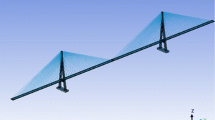Abstract
A finite element model of commercial vehicles was firstly built in the paper to study the virtual reality of vibration characteristics, and the top 6-order modal was then computed and compared with the experimental results to verify the reliability of the computational model. Then, a neural network model of the cabin was built. Through road tests, the excitation signal at the cabin suspension point and the response signal of interior vibration noise were measured under the idle condition and constant speed condition. The measured excitation signal was applied to the prediction model for frequency response analysis, in order to compute the interior noise within the range 20–200 Hz. The obtained simulation result of the vibration noise was compared with the experimental result and analyzed. As indicated from the analysis, the influence of excitation spectrum and the model can be reflected by the simulation response spectrum, which is consistent with the experimental result. The higher precision can be also obtained when the model is applied to predict the interior noise.










Similar content being viewed by others
References
Andrzej P, Tage B (2007) An investigation of the coupling between the passenger compartment and the truck in a sedan. SAE 2007:2356–2362
Norimasa K, Masami H, Hiroo Y (2009) Development for dynamic response analysis of acoustic trim. SAE 2009:1487–1493
Liu Y, Yu F, Liu J (2005) Modal analysis of vehicle compartment with acoustic-structure coupling. Noise Vib Control 5:38–40
Laurent G, Morad K, Energy D (2009) Field approach for low and medium frequency vibration acoustic analysis of a car body using a probabilistic computational model. SAE 2009:849–863
Kruntcheva MR (2007) Acoustic-structural coupling of the automobile passenger compartment. In: World congress on engineering, pp 1236–1241
Coroian A, Lupea I (2013) Improving the sound pressure level for a simplified passenger cabin by using modal participation and size optimization. Rom J Acoust Vib 10(1):100–106
Yansong W, Xintian L, Yan L (2010) A vibro-acoustic coupling analysis of bus passenger compartment based on the finite element method. In: International conference on intelligent computation technology and automation (ICICTA), 2010, vol 1. IEEE, pp 386–389
Zhang Y, Wu L (2009) Stock market prediction of S&P 500 via combination of improved BCO approach and BP neural network. Expert Syst Appl 36(5):8849–8854
Zhang L, Wu K, Zhong Y et al (2008) A new sub-pixel mapping algorithm based on a BP neural network with an observation model. Neurocomputing 71(10):2046–2054
Ruan JH, Shi Y (2016) Monitoring and assessing fruit freshness in IOT-based e-commerce delivery using scenario analysis and interval number approaches. Inf Sci 373(10):557–570
Guo Z, Wu J, Lu H et al (2011) A case study on a hybrid wind speed forecasting method using BP neural network. Knowl Based Syst 24(7):1048–1056
Fuh KH, Wang SB (1997) Force modeling and forecasting in creep feed grinding using improved BP neural network. Int J Mach Tools Manuf 37(8):1167–1178
Mehrara H, Zahedinejad M, Pourmohammad A (2009) Novel edge detection using BP neural network based on threshold binarization. In: Second international conference on computer and electrical engineering, 2009. ICCEE’09, vol 2. IEEE, pp 408–412
Pendharkar PC (2005) A threshold-varying artificial neural network approach for classification and its application to bankruptcy prediction problem. Comput Oper Res 32(10):2561–2582
Wei W, Fan X, Song H et al (2016) Imperfect information dynamic Stackelberg game based resource allocation using hidden markov for cloud computing. IEEE Trans Serv Comput 99:1–10
Li JQ, He SQ, Ming Z (2015) An intelligent wireless sensor networks system with multiple servers communication. Int J Distrib Sensor Netw 2015(6):1–9
Ruan JH, Wang XP (2016) Optimizing the intermodal transportation of emergency medical supplies using balanced fuzzy clustering. Int J Prod Res 54(14):4368–4386
Acknowledgements
This work is supported by National Natural Science Foundation of China (61503049), China Postdoctoral Science Foundation Funded Project (2016T90838; 2015M582525), Specialized Research Fund for the Doctoral Program of Higher Education of China (20135522110003) and Open Fund of Chongqing Key Laboratory of Traffic & Transportation (2016CQJY004).
Author information
Authors and Affiliations
Corresponding author
Ethics declarations
Conflict of interest
We declare that there is no conflict of interests regarding the publication of this paper.
Rights and permissions
About this article
Cite this article
Peng, J., Xu, L. & Shao, Y. Research on the virtual reality of vibration characteristics in vehicle cabin based on neural networks. Neural Comput & Applic 29, 1225–1232 (2018). https://doi.org/10.1007/s00521-016-2829-z
Received:
Accepted:
Published:
Issue Date:
DOI: https://doi.org/10.1007/s00521-016-2829-z




